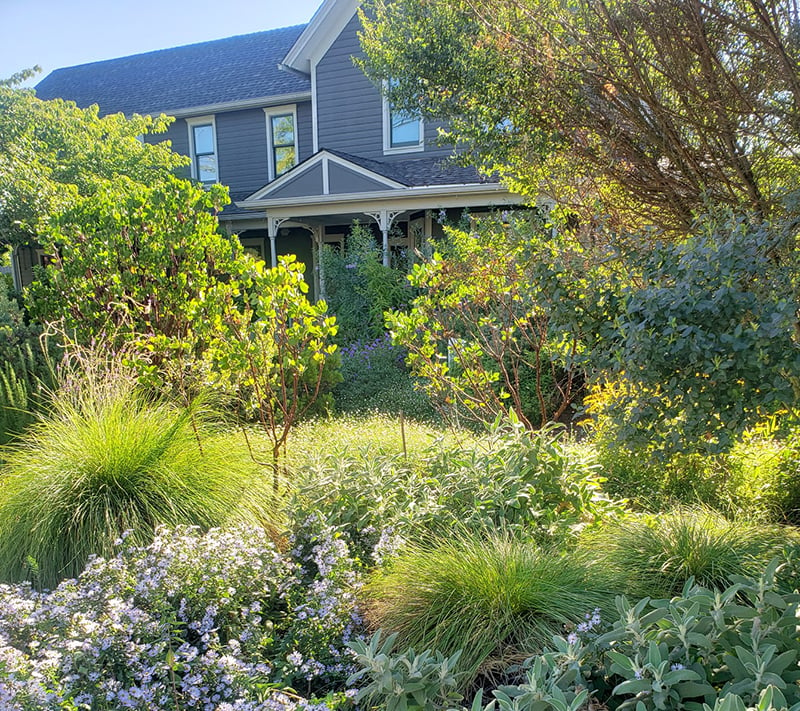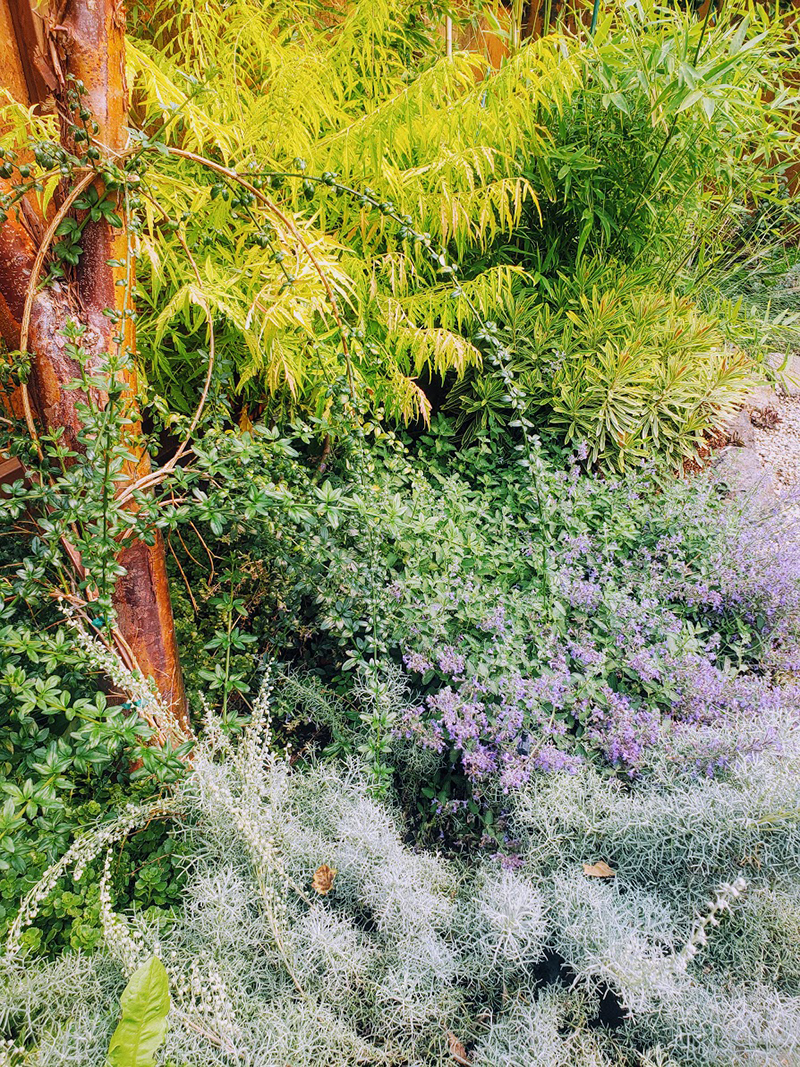
A Horticultural Adventure through the West: Oregon and Idaho

Contributor
My road trip from San Francisco to Boise to visit as many gardens and horticultural destinations as possible continues here to Oregon and Idaho. In the first leg, I went along the coast of Northern California, and you can find that article here. This voyage introduced me to a new world of plant species, landscape design philosophies, public engagement with plants, and the passionate, down-to-earth people who champion the timeless pursuit of horticulture.

Stop 8: The Oregon Garden

Imagined and created by the Oregon Association of Nurseries and now privately maintained, the Oregon Garden is an 80-acre display garden featuring the botanical highlights of what is grown and sold by the extensive Willamette Valley nursery industry. A series of themed gardens offers many ways to enjoy the outdoors and featured plants. The Pet Friendly Garden and Fire Safe Garden inform with creative displays. The excellent Children’s Garden is a wonderful opportunity for play and exploration for younger garden visitors, and the Sensory Garden is specifically designed with accessibility for disabled visitors. Water plays a major part of the design with the Amazing Water Garden’s pond and aquatic plants, while the Wetlands use treated wastewater to create wetland habit before it is used as irrigation water for the entire property. Perhaps the most interesting section for a horticulturist is the Conifer Garden. With one of the country’s largest collection of dwarf and miniature conifers tucked between pendulous pyramids and fuzzy, fascicled forms, this evergreen display has created at least one conifer convert from a conifer skeptic. For more on the Oregon Garden see https://www.pacifichorticulture.org/articles/the-oregon-garden/ .
Stop 9: Swan Island Dahlia Farm

If the timing is right, a brief stop at Swan Island Dahlia Farm is a fun and almost overwhelmingly colorful expedition. Open August through September, the Farm invites visitors to stroll between endless rows of dahlias in every form and color imaginable. Even dahlia enthusiasts will find it difficult to select a favorite. The names are perhaps as entertaining as the flowers themselves: Dahlia ‘I Do’ and ‘Bridezilla’ are dressed in white, while ‘Stiletto’ and ‘En Point’ have narrow pointed petals, and small-flowered forms have names like ‘Bambino’ and ‘Baby Red’. (Fair warning to horticulturists traveling with thrifters/antiquers or guilty of collecting themselves—it is local tradition for neighbors of the farm to host yard sales over Labor Day weekend.)
Stop 10: Argyle Garden at Argyle Tasting House

For any lover of modern, drought-tolerant landscape design, Argyle Winery’s Tasting House and Garden is an excellent source of inspiration. The overflowing borders of mixed flowers, grasses and bulbs that surround the Victorian-esque cottage seem to take inspiration from the classic English perennial border, but instead of lush foxgloves and penstemons you’ll find an array of xeric Salvia, Yucca, and Epilobium. Mass plantings of Restio and Carex against the clean negative space of decomposed granite paths or simple concrete patios create the perfect transition from the cottage to the newer, and more modern, barn-inspired tasting area. The gardens could be visited in a quick twenty-minute stroll, but why not stay and take in the grounds over a glass of their signature sparkling wine? The gardens were designed by Sean Hogan of Cistus Nursery, Sauvie Island, Oregon.
Stop 11: Portland Japanese Garden

The Portland Japanese Garden is not just a horticultural destination but a cultural one as well. Five distinct garden areas are authentic, classic Japanese garden designs that incorporate elements of stone, water, paths, bridges, water basins, and borrowed scenery to transport visitors from this West Coast hipster capital to a timeless and serene Japanese refuge. Lucky visitors might see horticulturists using traditional tools made from woven fibers or bamboo to rake debris from the immaculate carpets of moss or preen the bonsai collection. In the spirit of Japanese design, it is truly a four-season garden where painstakingly pruned conifers stand proud in winter, cherries weep in ruffled pink in spring, the waterfall and ponds glitter against lush green foliage in summer, and iconic Japanese maples come ablaze in fall. Though the plants are the obvious source of peace and tranquility in the garden, details in the design and construction of stone pathways and bamboo fencing add a distinct sense of the thoughtfulness and care intrinsic to Japan’s famous aesthetics. Unlike a botanical garden, this carefully designed and expertly maintained cultural garden is an exploration in humankind’s interest in and ability to shape, imitate, interpret, and revere nature, beyond simply displaying it.
Stop 12: International Rose Test Garden
https://www.portland.gov/parks/washington-park-international-rose-test-garden

As Portland is known as the City of Roses, it is only fitting the city should have a large and impressive rose garden. Just below the Portland Japanese Garden in Washington Park, the oldest rose test garden in the United States neatly displays over 600 cultivars of roses in long rows accompanied by a spectacular view of Mount Hood. Hybrid teas, floribundas, miniatures, and climbing roses of all colors create a delightful maze of scent and thorns for visitors, and a whole lot of dead-heading for the staff. About 90 percent of the collection is ephemeral, showcasing the most innovative and commercially available roses of the time, with approximately 30 beds being turned over each year. The Gold Medal permanent collection displays the best roses of the past 100 years selected annually by an expert panel. Each June the public is welcomed to vote for their favorite rose in the Portland’s Best Rose event.
Stop 13: Cistus Nursery

There is a cadre of West Coast horticulturists and designers leading the pack in a modern approach to landscape design that has an undeniable affection for striking, unusual plants that provide interesting texture, form, and foliage while being drought tolerant and Mediterranean climate adapted. One of the originals of this movement is Cistus Nursery, located on Portland’s Sauvie Island. The nursery’s stock and display gardens feature an eclectic selection of hardy tropicals and dry-growing rock stars from around the world (and around the corner) that thrive in a summer-dry climate. The nursery produces a wide variety of Arctostaphylos, Opuntia, Pittosporum, and a growing collection of western climate-adapted Quercus.
Stop 14: Hoyt Arboretum
https://www.hoytarboretum.org/

Just a short hike through the forest of Washington Park from the Japanese and Rose Gardens is Hoyt Arboretum, home to 2,300 species of trees and shrubs from around the world. Hillside trails and paths display an astounding diversity of bark, leaves, flowers, and seeds, some hanging from towering specimens planted as far back as the 1930s. A significant quantity of those species are rare or endangered and act as living genetic resources, should restoration of native populations become necessary. Highlights include the Magnolia, Acer, and conifer collections, as well as free admission.
Stop 15: Idaho Botanical Garden
https://idahobotanicalgarden.org/

This botanical garden is deeply rooted in the context of its location in the Penitentiary District of Idaho’s Treasure Valley. The garden itself is constructed over what used to be the exercise yard, vegetable garden, and orchard for the Old Idaho Penitentiary, itself now a historic building and museum next to the plantings. The gardens today still contain a large field for gatherings and a veggie garden, while other collections hearken deeper into the location’s history to include a memorable Lewis, Clark, and Sacagawea garden featuring many of the regional specimens collected on their famous 1804-1806 journey into the West. While the rose garden and English garden are a nod to garden trends of yore, the organization is looking forward to the sustainability of landscaping in this dry and harsh-winter climate by highlighting regionally-adapted plants in the waterwise, native, and firewise demonstration gardens. It is a delightful garden to get lost in, with a wonderful mix of subtle grays, browns, and tans of the native landscape and lush bursts of color beneath the trees or bordering views of the undeveloped corners of Treasure Valley.
Stop 16: Gossett Gardens
https://www.gossettlandscapedesign.com/

Over the past 24 years Steven Gossett, a local Boise landscape designer and plant enthusiast, has transformed an old junkyard into a magical secret garden just blocks away from the city’s popular Boise River Greenbelt. Daylilies are everywhere (a tried and true soil builder, he’s discovered) and a large clover lawn rests between mounded beds of perennials and evergreen trees. Though it appears to be merely a pleasure garden, it is in fact, his experimental garden where he is testing the local hardiness of numerous species of plants including evergreen magnolias and desert cacti and succulents. Though the garden doesn’t have regular hours, give Steve a ring to schedule a tour before or after a bike ride and picnic along the Greenbelt.
Stop 17: Edward’s Greenhouse and Flowershop
https://www.edwardsgreenhouse.com/

This locally-renowned retail outlet for plants and flowers is also home to a lovely acre-and-a-half Legacy Garden. One can zig-zag down the long, tree-lined grass allés while taking in lovely plantings of creatively color-coordinated shade perennials. The central gazebo has an assortment of hanging pots and containers and when the pandemic restrictions cease, live music events will be held here throughout the summer.
The beauty of traveling as a “plant nerd” is that no matter where we go, there will always be gardens and plants to ogle, ponder, identify, chastise, marvel at, and celebrate—any trip, even one around the block to walk the dog, is a horticultural trip. We are blessed in that the vibrant nature that surrounds us is further animated by our knowledge and curiosity of the botanical kingdom. Yet perhaps more striking to me than any of the plants or gardens I discovered were the people who tended them. Horticulturists are a warmly zealous bunch whose ears perk up at the utterance of a Latin moniker, the signaling of a fellow tribesman. They will enthusiastically divulge stories and discoveries and bend over backwards to indulge the curiosities of a like-minded colleague who sees the world in petioles, corms, and umbels. My memories of the gardens where I had the opportunity to speak with caretakers are richer and more vivid because of the illuminating interaction.
Our public gardens, a critical and already chronically underfunded public resource, need our financial support. The public, more home-bound than ever, needs these fresh-aired and vibrant spaces. If you live near a public garden that offers membership, I urge you to join, and then visit repeatedly. If you decide to have your own horticultural adventure, consider a membership with the American Horticultural Society to get free admission to participating gardens throughout North America.
https://ahsgardening.org/gardening-programs/rap/
SUGGESTED READING:
Donald Olson’s The Pacific Northwest Garden Tour










Responses